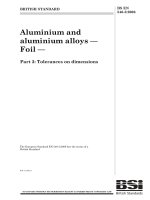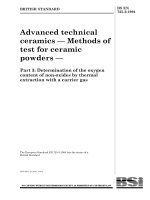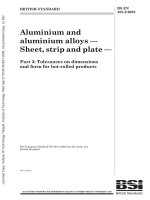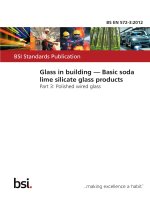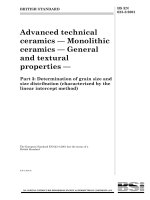Bsi bs en 13001 3 2 2014
Bạn đang xem bản rút gọn của tài liệu. Xem và tải ngay bản đầy đủ của tài liệu tại đây (1.32 MB, 40 trang )
BS EN 13001-3-2:2014
BSI Standards Publication
Cranes — General design
Part 3-2: Limit states and proof of
competence of wire ropes in reeving
systems
BS EN 13001-3-2:2014
BRITISH STANDARD
National foreword
This British Standard is the UK implementation of EN 13001-3-2:2014.
It supersedes DD CEN/TS 13001-3-2:2004, which is withdrawn.
This standard, together with BS EN 13001-1:2004+A1:2009,
BS EN 13001-2:2014, BS EN 13001-3-1:2012+A1:2013, BS EN
13001-3-3:2014, BS EN 13001-3-4 and DD CEN/TS 13001-3-5:2010,
supersedes BS 2573-1:1983 and BS 2573-2:1980, which will be
withdrawn on publication of all parts of the BS EN 13001 series.
Users’ attention is drawn to the fact that neither BS 2573-1:1983 nor
BS 2573-2:1980 should be used in conjunction with the EN 13001
series as they are not complementary. The BS 2573 series will remain
current until all parts of the BS EN 13001 series cited above have
been published to ensure that a coherent package of standards
remains available in the UK during the transition to European
standards.
The UK participation in its preparation was entrusted by Technical
Committee MHE/3, Cranes and derricks, to Subcommittee
MHE/3/1, Crane design.
A list of organizations represented on this subcommittee
can be obtained on request to its secretary.
This publication does not purport to include all the necessary
provisions of a contract. Users are responsible for its correct
application.
© The British Standards Institution 2014.
Published by BSI Standards Limited 2014
ISBN 978 0 580 79309 7
ICS 21.220.20; 53.020.20
Compliance with a British Standard cannot confer immunity from
legal obligations.
This British Standard was published under the authority of the
Standards Policy and Strategy Committee on 30 November 2014.
Amendments/corrigenda issued since publication
Date
Text affected
EN 13001-3-2
EUROPEAN STANDARD
NORME EUROPÉENNE
EUROPÄISCHE NORM
August 2014
ICS 21.220.20; 53.020.20
Supersedes CEN/TS 13001-3-2:2008
English Version
Cranes - General design - Part 3-2: Limit states and proof of
competence of wire ropes in reeving systems
Appareils de levage à charge suspendue - Conception
générale - Partie 3-2 : Etats limites et vérification d'aptitude
des câbles en acier mouflés
Krane - Konstruktion allgemein - Teil 3-2: Grenzzustände
und Sicherheitsnachweis von Drahtseilen in Seiltrieben
This European Standard was approved by CEN on 14 June 2014.
CEN members are bound to comply with the CEN/CENELEC Internal Regulations which stipulate the conditions for giving this European
Standard the status of a national standard without any alteration. Up-to-date lists and bibliographical references concerning such national
standards may be obtained on application to the CEN-CENELEC Management Centre or to any CEN member.
This European Standard exists in three official versions (English, French, German). A version in any other language made by translation
under the responsibility of a CEN member into its own language and notified to the CEN-CENELEC Management Centre has the same
status as the official versions.
CEN members are the national standards bodies of Austria, Belgium, Bulgaria, Croatia, Cyprus, Czech Republic, Denmark, Estonia,
Finland, Former Yugoslav Republic of Macedonia, France, Germany, Greece, Hungary, Iceland, Ireland, Italy, Latvia, Lithuania,
Luxembourg, Malta, Netherlands, Norway, Poland, Portugal, Romania, Slovakia, Slovenia, Spain, Sweden, Switzerland, Turkey and United
Kingdom.
EUROPEAN COMMITTEE FOR STANDARDIZATION
COMITÉ EUROPÉEN DE NORMALISATION
EUROPÄISCHES KOMITEE FÜR NORMUNG
CEN-CENELEC Management Centre: Avenue Marnix 17, B-1000 Brussels
© 2014 CEN
All rights of exploitation in any form and by any means reserved
worldwide for CEN national Members.
Ref. No. EN 13001-3-2:2014 E
BS EN 13001-3-2:2014
EN 13001-3-2:2014 (E)
Contents
Page
Foreword ..............................................................................................................................................................4
Introduction .........................................................................................................................................................5
1
Scope ......................................................................................................................................................6
2
Normative references ............................................................................................................................6
3
3.1
3.2
Terms, definitions, symbols and abbreviations .................................................................................7
Terms and definitions ...........................................................................................................................7
Symbols and abbreviations ..................................................................................................................7
4
4.1
4.2
4.3
4.4
4.5
General ....................................................................................................................................................9
Running ropes........................................................................................................................................9
Stationary ropes.....................................................................................................................................9
Discard criteria .................................................................................................................................... 10
Rope and rope terminations .............................................................................................................. 10
Documentation .................................................................................................................................... 10
5
5.1
5.2
5.2.1
5.2.2
5.2.3
5.2.4
5.2.5
5.3
5.3.1
5.3.2
5.3.3
5.3.4
5.3.5
5.4
Proof of static strength ...................................................................................................................... 10
General ................................................................................................................................................. 10
Vertical hoisting .................................................................................................................................. 10
Design rope force ............................................................................................................................... 10
Inertial and gravitational effects ........................................................................................................ 11
Rope reeving efficiency ..................................................................................................................... 12
Non parallel falls ................................................................................................................................. 13
Horizontal forces on the hoist load................................................................................................... 13
Non vertical drives .............................................................................................................................. 14
Design rope force ............................................................................................................................... 14
Equivalent force .................................................................................................................................. 15
Inertial effects...................................................................................................................................... 16
Rope reeving efficiency ..................................................................................................................... 17
Non parallel falls ................................................................................................................................. 17
Limit design rope force ...................................................................................................................... 17
6
6.1
6.2
6.2.1
6.2.2
6.2.3
6.2.4
6.3
6.3.1
6.3.2
6.3.3
6.3.4
6.4
6.4.1
6.4.2
6.4.3
6.4.4
6.4.5
Proof of fatigue strength .................................................................................................................... 18
General ................................................................................................................................................. 18
Design rope force ............................................................................................................................... 18
Principle conditions............................................................................................................................ 18
Inertial effects...................................................................................................................................... 19
Non parallel falls ................................................................................................................................. 19
Horizontal forces in vertical hoisting................................................................................................ 20
Limit design rope force ...................................................................................................................... 21
Basic formula ...................................................................................................................................... 21
Rope force history parameter............................................................................................................ 21
Rope force spectrum factor ............................................................................................................... 21
Relative total number of bendings .................................................................................................... 22
Further influences on the limit design rope force ........................................................................... 22
Basic formula ...................................................................................................................................... 22
Diameters of drum and sheaves ....................................................................................................... 23
Tensile strength of wire ..................................................................................................................... 23
Fleet angle ........................................................................................................................................... 23
Rope lubrication.................................................................................................................................. 24
2
BS EN 13001-3-2:2014
EN 13001-3-2:2014 (E)
6.4.6
6.4.7
6.5
Groove .................................................................................................................................................. 25
Rope types ........................................................................................................................................... 25
Additional requirements for multilayer drum ................................................................................... 26
7
7.1
7.2
Stationary ropes .................................................................................................................................. 27
Proof of static strength ....................................................................................................................... 27
Proof of fatigue strength..................................................................................................................... 27
Annex A (normative) Number of relevant bendings .................................................................................... 29
Annex B (informative) Guidance for selection of design number of hoist ropes lr used during the
design life of crane .............................................................................................................................. 33
Annex C (informative) Selection of a suitable set of crane standards for a given application ............... 34
Annex ZA (informative) Relationship between this European Standard and the Essential
Requirements of EU Directive 2006/42/EC ........................................................................................ 35
Bibliography ...................................................................................................................................................... 36
3
BS EN 13001-3-2:2014
EN 13001-3-2:2014 (E)
Foreword
This document (EN 13001-3-2:2014) has been prepared by Technical Committee CEN/TC 147 “Crane —
Safety”, the secretariat of which is held by BSI.
This European Standard shall be given the status of a national standard, either by publication of an identical
text or by endorsement, at the latest by February 2015 and conflicting national standards shall be withdrawn
at the latest by February 2015.
Attention is drawn to the possibility that some of the elements of this document may be the subject of patent
rights. CEN [and/or CENELEC] shall not be held responsible for identifying any or all such patent rights.
This document supersedes CEN/TS 13001-3-2:2008.
CEN/TC 147/WG 2 has reviewed CEN/TS 13001-3-2:2008 to adapt the standard to the technical progress.
The major changes in this document are in the following clauses:
—
6.3 and 6.5;
—
there are new issues in Clause 7.
The provisions of this standard shall not be mandatory to cranes manufactured within the first 12 months
following the date of availability (DAV) of the standard.
This document has been prepared under a mandate given to CEN by the European Commission and the
European Free Trade Association, and supports essential requirements of EU Directive(s).
For relationship with EU Directive(s), see informative Annex ZA, which is an integral part of this document.
This European Standard is one Part of EN 13001, Cranes — General design. The other parts are as follows:
—
Part 1: General principles and requirements
—
Part 2: Load actions
—
Part 3-1: Limit states and proof of competence of steel structures
—
Part 3-3: Limit states and proof of competence of wheel/rail contacts
—
Part 3-4: Limit states and proof of competence of machinery
—
Part 3-5: Limit states and proof of competence of forged hooks
According to the CEN-CENELEC Internal Regulations, the national standards organizations of the following
countries are bound to implement this European Standard: Austria, Belgium, Bulgaria, Croatia, Cyprus, Czech
Republic, Denmark, Estonia, Finland, Former Yugoslav Republic of Macedonia, France, Germany, Greece,
Hungary, Iceland, Ireland, Italy, Latvia, Lithuania, Luxembourg, Malta, Netherlands, Norway, Poland, Portugal,
Romania, Slovakia, Slovenia, Spain, Sweden, Switzerland, Turkey and the United Kingdom.
4
BS EN 13001-3-2:2014
EN 13001-3-2:2014 (E)
Introduction
This European Standard has been prepared to be a harmonized standard to provide one means for the
mechanical design and theoretical verification of cranes to conform to the essential health and safety
requirements of the Machinery Directive, as amended. This standard also establishes interfaces between the
user (purchaser) and the designer, as well as between the designer and the component manufacturer, in
order to form a basis for selecting cranes and components.
This European Standard is a type C standard as stated in EN ISO 12100.
The machinery concerned and the extent to which hazards, hazardous situations and events are covered are
indicated in the scope of this standard.
When provisions of this type C standard are different from those which are stated in type A or B standards, the
provisions of this type C standard take precedence over the provisions of the other standards, for machines.
5
BS EN 13001-3-2:2014
EN 13001-3-2:2014 (E)
1
Scope
This European Standard is to be used together with EN 13001-1 and EN 13001-2 and as such they specify
general conditions, requirements and methods to prevent mechanical hazards of wire ropes of cranes by
design and theoretical verification.
NOTE
Specific requirements for particular types of cranes are given in the appropriate European Standard for the
particular crane type.
The following is a list of significant hazardous situations and hazardous events that could result in risks to
persons during intended use and reasonably foreseeable misuse. Clauses 5 to 6 of this standard are
necessary to reduce or eliminate risks associated with the following hazard:
−
exceeding the limits of strength (yield, ultimate, fatigue).
This European Standard is not applicable to cranes which are manufactured before the date of its publication
as EN and serves as reference base for the European Standards for particular crane types (see Annex C).
EN 13001-3-2 deals only with the limit state method in accordance with EN 13001-1.
2
Normative references
The following documents, in whole or in part, are normatively referenced in this document and are
indispensable for its application. For dated references, only the edition cited applies. For undated references,
the latest edition of the referenced document (including any amendments) applies.
EN 1990:2002, Eurocode — Basis of structural design
EN 12385-2, Steel wire ropes — Safety — Part 2: Definitions, designation and classification
EN 12385-4, Steel wire ropes — Safety — Part 4: Stranded ropes for general lifting applications
EN 13001-1, Cranes — General design — Part 1: General principles and requirements
EN 13001-2, Crane safety — General design — Part 2: Load actions
EN 13411-1, Terminations for steel wire ropes — Safety — Part 1: Thimbles for steel wire rope slings
EN 13411-2, Terminations for steel wire ropes — Safety — Part 2: Splicing of eyes for wire rope slings
EN 13411-3, Terminations for steel wire ropes — Safety — Part 3: Ferrules and ferrule-securing
EN 13411-4, Terminations for steel wire ropes — Safety — Part 4: Metal and resin socketing
EN 13411-6, Terminations for steel wire ropes — Safety — Part 6: Asymmetric wedge socket
EN ISO 12100:2010, Safety of machinery — General principles for design — Risk assessment and risk
reduction (ISO 12100:2010)
ISO 4306-1:2007, Cranes — Vocabulary — Part 1: General
ISO 4309, Cranes — Wire ropes — Care and maintenance, inspection and discard
6
BS EN 13001-3-2:2014
EN 13001-3-2:2014 (E)
3
Terms, definitions, symbols and abbreviations
3.1 Terms and definitions
For the purposes of this document, the terms and definitions given in EN ISO 12100:2010 and the basic list of
definitions as provided in EN 1990:2002 apply. For the definitions of loads, Clause 6 of ISO 4306-1:2007
applies.
3.2 Symbols and abbreviations
The symbols and abbreviations used in this Part of the EN 13001 are given in Table 1.
Table 1— Symbols and abbreviations
Symbols,
abbreviations
Description
a
Acceleration
C
Total number of working cycles (see EN 13001–1) during design life of crane
D
Relevant diameter
Ddrum
Minimum pitch diameter of drum
Dsheave
Minimum pitch diameter of sheave
Dcomp
Minimum pitch diameter of compensating sheave
d
dbearing
Rope diameter
Diameter of bearing or shaft
Fequ
Equivalent force
Fgd
Part of Fequ induced by gravity, exclusive of mass of payload, amplified by γp
Fgl
Part of Fequ induced by gravity forces of mass of payload, amplified by γp
Fo
Part of Fequ induced by any other forces, amplified by γp
FRd,s
Limit design rope force for the proof of static strength
FRd,f
Limit design rope force for the proof of fatigue strength
FSd,s
Design rope force for the proof of static strength
Fr
Part of Fequ induced by resistances, amplified by γp
FSd,f
Design rope force for the proof of fatigue strength
Ft
Part of Fequ induced by rope tightening forces, amplified by γp
Fu
Minimum rope breaking force
Fw
Part of Fequ induced by wind forces, amplified by γp
ff
Factor of further influences
ff1
Factor of diameter ratio influence
ff2
Factor tensile strength of wire influence
7
BS EN 13001-3-2:2014
EN 13001-3-2:2014 (E)
Symbols,
abbreviations
8
Description
ff3
Factor of fleet angle influence
ff4
Factor of lubrication influence
ff5
Factor of multilayer drum influence
ff6
Factor of groove radius influence
ff7
Factor of rope type influence
fS1
Rope force increasing factor from rope reeving efficiency
fS2
Rope force increasing factor from non parallel falls
fS3
Rope force increasing factor from horizontal acceleration
fsi*
Rope force increasing factors in fatigue
g
Acceleration due to gravity
i
Index for cycles of lifting and lowering
imax
Total number of movements
kr
Rope force spectrum factor
lr
Number of ropes used during design life of the crane
q
Normalized height distribution
mH
Mass of hoist load (see EN 13001–2)
mHr
Mass of hoist load that is acting on the rope falls under consideration
mr
Rotatory rope driven mass
mt
Translational rope driven mass
ns
Number of fixed sheave between drum and moving part
nm
Mechanical advantage
nr
Number of ropes reeved from a drum
R0
Minimum tensile strength of the wire used in the rope
RDd
Reference ratio of rope bending diameter to rope diameter
Rr
Tensile strength level of wire
rg
Groove radius
sr
Rope force history parameter
t
Rope type factor
w
Number of relevant bendings per movement
wc
Bending count
wD
Number of bendings at reference point
wtot
Total number of bendings
BS EN 13001-3-2:2014
EN 13001-3-2:2014 (E)
Symbols,
abbreviations
z, zi, zmin, zmax, zref
α
β, βmax
4
Description
Height coordinates
Angle of slope
Angles between falls and line of acting force
γ
Angle between gravity and projected rope in plane of Fh and g
γn
Risk coefficient
γp
Partial safety factor
γrb
Minimum rope resistance factor (static)
γrf
Minimum rope resistance factor (fatigue)
δ
Design fleet angle
ε
Angle between sheave planes
ηs
Efficiency of single sheave
ηtot
Total rope reeving efficiency
νr
Relative total number of bendings
φ
Dynamic factor for inertial or gravity effects
φ*
Dynamic factor for inertial or gravity effects in fatigue
φ2
Dynamic factor for hoisting an unrestrained grounded load
φ5
Dynamic factor for loads caused by acceleration
φ6
Dynamic factor for test load
ω
Angle between the sheave groove sides
General
4.1 Running ropes
Running wire ropes in cranes are stressed by loads and by bendings. Together these constitute a cumulative
fatigue effect on the rope, which is expressed as a rope force history parameter sr. The rope force history
parameter is independent of time.
The proof of competence for static strength and the proof of competence for fatigue strength shall be fulfilled
for the selection of ropes and components.
4.2 Stationary ropes
Stationary ropes are considered as part of the crane structure.
Clause 7 gives the requirements for the proof of competence for static strength and for fatigue strength of
stationary ropes.
9
BS EN 13001-3-2:2014
EN 13001-3-2:2014 (E)
4.3 Discard criteria
To ensure safe use of the rope, the discard criteria in accordance with ISO 4309 shall be applied.
When polymer sheaves are used exclusively in conjunction with single-layer spooling, the deterioration of the
rope is likely to advance at a greater rate internally than externally and the discard criteria in accordance with
ISO 4309 cannot be applied.
4.4 Rope and rope terminations
The wire rope should be in accordance with EN 12385-4. Rope terminations shall meet the requirements of
EN 13411-1, EN 13411-2, EN 13411-3, EN 13411-4 and EN 13411-6.
4.5 Documentation
The documentation of the proof of competence shall include:
—
design assumptions including calculation models;
—
applicable loads and load combinations;
—
rope specification and number of ropes specified for the design;
—
relevant limit states;
—
results of the proof of competence calculation and tests when applicable.
5
Proof of static strength
5.1 General
For the proof of static strength it shall be proven that for all relevant load combinations of EN 13001-2
FSd,s ≤ FRd,s
(1)
where
FSd,s
is the design rope force;
FRd,s
is the limit design rope force.
5.2 Vertical hoisting
5.2.1
Design rope force
The design rope force FSd,s in vertical hoisting shall be calculated as follows:
F=
Sd,s
where
10
mHr ⋅ g
nm
⋅ φ × fS1 × fS2 × fS3 × γp × γn
(2)
BS EN 13001-3-2:2014
EN 13001-3-2:2014 (E)
mHr
is the mass of the hoist load (mH) or that part of the mass of the hoist load that is acting on the
rope falls under consideration (see Figure 1). The mass of the hoist load includes the masses
of the payload, lifting attachments and a portion of the suspended hoist ropes. In statically
undetermined systems, the unequal load distribution between ropes depends on elasticities
and shall be taken into account;
g
is the acceleration due to gravity;
nm
is the mechanical advantage of falls carrying mHr;
φ
is the dynamic factor for inertial and gravity effects as shown in 5.2.2;
fS1 to fS3
are the rope force increasing factors as shown in 5.2.3 to 5.2.5;
γp
is the partial safety factor (see EN 13001–2):
γp = 1,34
for regular loads (load combinations A),
γp = 1,22
for occasional loads (load combinations B),
γp = 1,10
or exceptional loads (load combinations C);
γn
is the risk coefficient (see EN 13001–2), where applicable.
Figure 1 — Example for the acting parts of hoist mass
5.2.2
Inertial and gravitational effects
5.2.2.1
Dynamic factors
For vertical hoisting the maximum inertial effects from either hoisting an unrestrained grounded load or from
acceleration or deceleration shall be taken into account by the dynamic factor ϕ, given in 5.2.2.2 to 5.2.2.4.
5.2.2.2
φ = φ2
Hoisting an unrestrained grounded load
(3)
where
11
BS EN 13001-3-2:2014
EN 13001-3-2:2014 (E)
ϕ2 is the dynamic factor for inertial and gravity effects when hoisting an unrestrained grounded
load (see EN 13001-2).
5.2.2.3
Acceleration or deceleration of the suspended load
a
g
φ =1 + φ5 ×
(4)
where
φ5
is the dynamic factor for loads caused by acceleration (see EN 13001–2);
a
is the vertical acceleration or deceleration;
g
is the acceleration due to gravity.
5.2.2.4
Test load
φ = φ6
(5)
where
φ6
5.2.3
is the dynamic factor for test load (see EN 13001-2).
Rope reeving efficiency
The rope force increasing factor from rope reeving efficiency f S1 shall be calculated as follows:
fS1 =
1
(6)
ηtot
The total rope reeving efficiency of the rope drive ηtot shall be calculated as follows:
ηtot
=
(ηS )
ns
nm
×
1 − (ηS )
nm
(7)
1 − ηS
where
ηS
is the efficiency of a single sheave:
ηS = 0,985
for sheave with roller bearing,
ηS = 0,985 × (1 − 0,15 × dbearing/DSheave)
for sheave with plain bearing.
Other values for ηS may be used if verified by test results for
the applied rope, sheave and bearing.
12
nm
is the mechanical advantage (see example in Figure 2);
ns
is the number of fixed sheaves between drum and moving
part.
BS EN 13001-3-2:2014
EN 13001-3-2:2014 (E)
Figure 2 — Example for a rope reeving
5.2.4
Non parallel falls
When the rope falls are not parallel, the rope force is increased. The rope force increasing factor fS2 shall be
determined for the most unfavourable position. For simplification fS2 may be calculated by
fS2 =
1
cos βmax
(8)
where
βmax
is the maximum angle between the falls and the direction of load (see Figure 3).
Figure 3 — Angle βmax
5.2.5
Horizontal forces on the hoist load
The rope force increasing effect of the horizontal forces (e.g. by trolley or crane accelerations, wind) may be
neglected in applications with free swinging loads.
However in applications with several non-parallel ropes (rope pyramid, see Figure 4) the horizontal forces
increase the rope force considerably. This effect shall be taken into account. For simplification the rope force
increasing factor fS3 may be calculated by
13
BS EN 13001-3-2:2014
EN 13001-3-2:2014 (E)
Fh
fS3 =
1+
≤2
mH × g × tan γ
(9)
where
Fh
is the horizontal force on the hoist load;
mH
is the mass of the hoist load;
g
is the acceleration due to gravity;
γ
is the angle between direction of gravity and the rope projected in the plane determined by Fh and
direction of gravity.
Figure 4 — Load suspension with inclined ropes
Load actions due to φ and fS3 in Formula (2) may be handled separately, only in cases where simultaneous
action of horizontal and vertical accelerations is prevented by technical means (e.g. by a control system).
5.3 Non vertical drives
5.3.1
Design rope force
The design rope force FSd,s in non-vertical drives (see examples in Figure 5 and Figure 6) shall be calculated
as follows:
=
FSd,s
Fequ
nm
× φ × fS1 × fS2 × γn
(10)
where
14
Fequ
is the equivalent force acting on the reeving system under consideration as shown in 5.3.2. In
statically undetermined systems, the unequal load distribution between ropes depends on
elasticities and shall be taken into account;
nm
is the mechanical advantage of the reeving;
φ
is the dynamic factor for inertial effects as shown in 5.3.3;
fS1, fS2
are the rope force increasing factors as shown in 5.3.4 and 5.3.5;
γn
is the risk coefficient (see EN 13001–2), where applicable.
BS EN 13001-3-2:2014
EN 13001-3-2:2014 (E)
Key
mr1, mr2, mr3
rotatory rope driven masses, referred to the coordinate of acceleration
mt1, mt2
translational rope driven masses, referred to the coordinate of acceleration
Fequ, Fw, Fr
forces, see 5.3.2
Acc., a
accelerations
nm
mechanical advantage
Figure 5 — Examples for non-vertical drive
Key
mr1, mr2, mr3
rotatory rope driven masses, referred to the coordinate of acceleration
mt
translational rope driven mass, referred to the coordinate of acceleration
Ft
tightening forces, see 5.3.2
nm
mechanical advantage
Figure 6 — Example for rope tightening
5.3.2
Equivalent force
In general the load actions of gravity forces, resistances (e.g. rolling or gliding, wheels, bearings), rope
tightening forces, wind forces and any other forces (e.g. buffer forces, forces from climatic effects) contribute
to the equivalent force Fequ as illustrated in Formula (11). The individual load actions shall be amplified by the
relevant partial safety factors γp (see EN 13001-2) for the load combination under consideration, as given in
Table 2.
15
BS EN 13001-3-2:2014
EN 13001-3-2:2014 (E)
Fequ = Fgd + Fgl + Fr + Fw + Ft + Fo
(11)
where
Fgd
is that part of Fequ that is induced by gravity forces of the rope driven masses, exclusive of the mass
of the payload;
Fgl
is that part of Fequ that is induced by gravity forces of the rope driven mass of the payload;
Fr
is that part of Fequ that is induced by resistances;
Fw
is that part of Fequ that is induced by wind forces;
Ft
is that part of Fequ that is induced by rope tightening forces (see example in Figure 6);
Fo
is that part of Fequ that is induced by any other forces.
Table 2 — Partial safety factors γp
Description
Regular loads
Occasional loads
Exceptional loads
Load combinations A
Load combinations B
Load combinations C
Fgd
Gravitation on masses,
exclusive of mass of
payload
1,22
1,16
1,1
Fgl
Gravitation on payload
1,34
1,22
1,1
Inertia
1,34
1,22
1,1
Fr
Resistances
1,34
1,22
1,1
Ft
Rope tightening
1,22
1,16
1,1
Wind forces: in service
—
1,22
1,16
Wind forces:
service
—
—
1,1
Snow and ice
—
1,22
1,1
Temperature
—
1,16
1,05
Buffer forces
—
—
1,1
φ
Fw
Fo
5.3.3
out
of
Inertial effects
In non-vertical drives the inertial effects from accelerations shall be taken into account by the dynamic factor φ
calculated as follows:
φ = 1+
( ∑ mt + ∑ mr ) × a × φ5 × γ p
Fequ
(12)
where
16
Σmt
is the sum of translational rope driven masses, referred to the coordinate of acceleration;
Σmr
is the sum of rotatory rope driven masses (see examples in Figure 5 and Figure 6), referred to the
coordinate of acceleration;
BS EN 13001-3-2:2014
EN 13001-3-2:2014 (E)
a
is the acceleration or deceleration;
φ5
is the dynamic factor for loads caused by acceleration (see EN 13001–2);
γp
is the partial safety factor, as given in Table 2, line inertia;
Fequ
is the equivalent force.
5.3.4
Rope reeving efficiency
The increase of the design rope force by the rope reeving efficiency shall be taken into account by the rope
force increasing factor fS1, calculated as shown in 5.2.3, Formulae (6) and (7).
5.3.5
Non parallel falls
The increase of the design rope force by non-parallel falls shall be taken into account by the rope force
increasing factor fS2, calculated as shown in 5.2.4 and Formula (8).
5.4 Limit design rope force
The limit design rope force FRd,s shall be calculated by
FRd,s =
Fu
(13)
γrb
where
Fu
is the specified minimum breaking force of the rope;
γrb
is the minimum rope resistance factor.
The minimum rope resistance factor γrb is dependent on the geometry of the reeving system and is given by
γrb =
1,35 +
5,0
D
d
0,8
≥ 2,07
(14)
−4
where
D
is the minimum relevant diameter: D = Min (Dsheave; 1,125 × Ddrum; 1,125 × Dcomp);
d
is the rope diameter.
The chosen ratio D/d shall not be less than 11,2.
Table 3 gives minimum rope resistance factors for selected ratios of D/d.
Table 3 — Minimum rope resistance factor γrb
D/d
11,2
12,5
14,0
16,0
18,0
≥ 20,0
γrb
3,07
2,76
2,52
2,31
2,17
2,07
17
BS EN 13001-3-2:2014
EN 13001-3-2:2014 (E)
6
Proof of fatigue strength
6.1 General
According to test results the fatigue strength of ropes in terms of number of bendings (rope force to number of
bendings relationship) is approximately inversely proportional to the second power of the applied rope tension
force. With the additional requirement that the ratio of the rope bending diameter D to the rope diameter d
increases with the number of bendings wtot according to
log ( w )
D
~ 1,125 2 tot
d
(15)
(i.e. D/d increases by 1,125 for increasing wtot by 2), the rope force to number of bendings relationship is
closely inversely proportional to the power of 3. Therefore, this additional criteria is used in the calculation of
the rope force history.
When counting bendings on a rope all movements, with or without load, included in a work cycle as specified
for the crane, shall be taken into account. In the rope force spectrum calculation movements at different force
levels are calculated separately. For details of bending counting, see Annex A.
For the proof of fatigue strength it shall be proven that
FSd,f ≤ FRd,f
(16)
where
FSd,f
is the design rope force for fatigue;
FRd,f
is the limit design rope force for fatigue;
6.2 Design rope force
6.2.1
Principle conditions
The design rope force FSd,f shall be calculated for regular loads (load combinations A, see EN 13001-2) only,
with partial safety factors γp and rope reeving efficiency ηtot set to 1.
For vertical hoisting:
F=
Sd,f
mHr × g
nm
*
*
× φ * × fS2
× fS3
×γn
(17)
where
mHr
is the mass of the hoist load (mH) or that part of the mass of the hoist load that is acting on the
rope (see Figure 1);
g
is the acceleration due to gravity (gravity constant);
nm
is the mechanical advantage of falls carrying mHr;
ϕ*
is the dynamic factor for inertial and gravity effects as shown in 6.2.2;
*
fS2
18
f*
, S3
are the rope force increasing factors as shown in 6.2.3 to 6.2.4.
BS EN 13001-3-2:2014
EN 13001-3-2:2014 (E)
γn
is the risk coefficient (see EN 13001–2), where applicable.
For non-vertical drives:
FSd,f=
Fequ
nm
*
× φ * × fS2
×γn
(18)
where
Fequ
is the equivalent force acting on the rope according to the principles of 5.3.2;
nm
is the mechanical advantage of the reeving;
ϕ*
is the dynamic factor for inertial effects as shown in 6.2.2;
is the rope force increasing factor as shown in 6.2.3;
*
fS2
γn
is the risk coefficient (see EN 13001–2), where applicable.
For vertical and non-vertical drives the following applies:
—
*
Instead of the rope force increasing factors fsi the factors fsi as given in Clause 5 may be used.
—
Instead of the dynamic factor φ* the factor φ as given in Clause 5 may be used.
6.2.2
Inertial effects
As the inertial effects act for short time only, they do not affect all bendings. Therefore the dynamic factors φ*
may be calculated by
*
φ =
3
( w − 1) + φ 3
for w ≥ 1
(19)
w
for w = 0,5
φ* = φ
where
6.2.3
w
is the relevant number of bendings per movement;
φ
is the dynamic factor (see 5.2.2 or 5.3.3).
Non parallel falls
Non parallel falls shall be taken into account in the proof of fatigue strength. The distribution of height and
*
.
angle within the working range can be taken into account by the rope force increasing factor fS2
When the crane operates approximately equal on all heights of the most frequent working range, the density
function is constant
q( z ) =
1
z2 − z1
(20)
*
may be calculated as
and fS2
19
BS EN 13001-3-2:2014
EN 13001-3-2:2014 (E)
*
fS2
z − z2
1
=1 +
− 1 × ref
cos β ( z2 ) zref − z1
0,9
(21)
*
should be calculated as
In general cases fS2
*
fS2
=3
zmax
∫
zmin
q( z )
cos3 β ( z )
dz
(22)
where
z
are height coordinates as shown in Figure 7,
zref
is the reference height,
the whole working range is from zmin to zmax,
the most frequent working range is from z1 to z2;
β(z)
is the angle between rope and line of the acting force;
q(z)
is the normalized height density of the crane, when used in the working range, where
Zmax
∫
q ( z ) dz = 1
(23)
zmin
Figure 7 — Lifting positions
6.2.4
Horizontal forces in vertical hoisting
*
shall be calculated by
In applications with several non-parallel ropes (rope pyramid, see Figure 4), fS3
*
fS3
= fS3
where
fS3
20
is the rope force increasing factor calculated from an average angle γ (see 5.2.5).
(24)
BS EN 13001-3-2:2014
EN 13001-3-2:2014 (E)
When horizontal forces and lifting acceleration do not act together regularly or where there is a considerable
*
difference in acceleration time, fS3
may be set to 1.
6.3 Limit design rope force
6.3.1
Basic formula
The limit design rope force FRd,f shall be calculated by
FRd,f
=
Fu
γ rf × 3 sr
× ff
(25)
where
Fu
is the specified minimum breaking force of the rope ;
sr
is the rope force history parameter;
γrf
is the minimum rope resistance factor: γrf = 7;
γrf combines a safety factor (taking into account the uncertainty of fatigue strength values and
the possible consequences of fatigue damage) and a factor that reduces Fu to fatigue strength
at reference point (see 6.3.4);
ff
6.3.2
is the factor of further influences (see 6.4 and Formula (30)).
Rope force history parameter
In analogy to stress history parameter in accordance with EN 13001-1, the rope force history parameter is
given by
s=
kr × νr
r
(26)
where
6.3.3
kr
is the rope force spectrum factor;
νr
is the relative total number of bendings.
Rope force spectrum factor
The rope force spectrum factor kr is calculated by
imax
∑
=
kr
i =1
FSd,f,i
F
Sd,f
3
w
× i
wtot
(27)
where
i
is the index of one movement with FSd,f,i;
imax
is the total number of movements per rope. All the working cycles C shall be taken into
account, numbers of which per rope equals to C/lr;
21
BS EN 13001-3-2:2014
EN 13001-3-2:2014 (E)
FSd,f,i
is the design rope force in movement i;
FSd,f
is the maximum design rope force;
wi
is the relevant number of bendings in one movement i (see Annex A);
wtot
is the total number of bendings during the design life of a rope;
C
is the total number of working cycles during the design life of the crane in accordance with
EN 13001–1;
lr
is the number of ropes specified for the design life of the crane (guidance for lr is given in the
Annex B).
The total number of bendings wtot is calculated by
wtot =
imax
∑ wi
(28)
i =1
where
6.3.4
wi
is the relevant number of bendings per movement (see Annex A);
imax
is the total number of movements per rope.
Relative total number of bendings
The relative total number of bendings is calculated by
νr =
wtot
(29)
wD
where
wtot
is the total number of bendings during the design life of a rope;
wD
is the number of bendings at reference point:
wD= 5 ⋅ 105
6.4 Further influences on the limit design rope force
6.4.1
Basic formula
The factor ff takes into account further influences on the limit design rope force:
f f = f f1 × f f2 × f f3 × f f4 × f f5 × f f6 × f f7
where
ff1 to ff7
22
are the factors of influences as given in 6.4.2 to 6.4.6.
(30)
BS EN 13001-3-2:2014
EN 13001-3-2:2014 (E)
6.4.2
Diameters of drum and sheaves
The additional requirement of 6.1 that the ratio D/d of the rope bending diameter D to the rope diameter d
increases with the number of bendings wtot according to Formula (15), is incorporated in Formula (32).
D shall be calculated by
(31)
=
D Min Dsheave ;1,125 × Ddrum ;1,125 × Dcomp
The reference ratio value of D/d is calculated by
RDd
=
w
log2 tot
8000
10 × 1,125
(32)
and thus increses with increasing total number of bendings.
The factor ff1 is calculated by
ff 1 =
D
d
RDd
(33)
The chosen ratio D/d shall not be less than 11,2 and shall be selected such that ff1 becomes equal or greater
than 0,75.
Table 4 gives commonly used values of ratio D/d:
Table 4 — Commonly used values of ratio D/d
D/d
6.4.3
11,2
12,5
14,0
16,0
18,0
20,0
22,4
25,0
28,0
31,5
Tensile strength of wire
A nonlinear relationship between the rope grade Rr of the wire and the limit design rope force shall be taken
into account by
1770
f f2 =
R
r
0,6
ff 2 = 1 ,
,
for Rr > 1 770
(34)
for Rr ≤ 1 770
where
Rr
is the rope grade, which is designated by a number (e.g. 1 770, 1 960), in accordance with EN 12385-4.
6.4.4
Fleet angle
Fleet angles at sheaves or drums are illustrated in Figure 8. Fleet angles shall always be counted positive. For
a selected point (P) of the rope, the design fleet angle δ being associated with the most frequent working
range (Z1 to Z2) shall be taken into account by factor ff3 as given in Table 5. The design fleet angle shall be
calculated by
23


